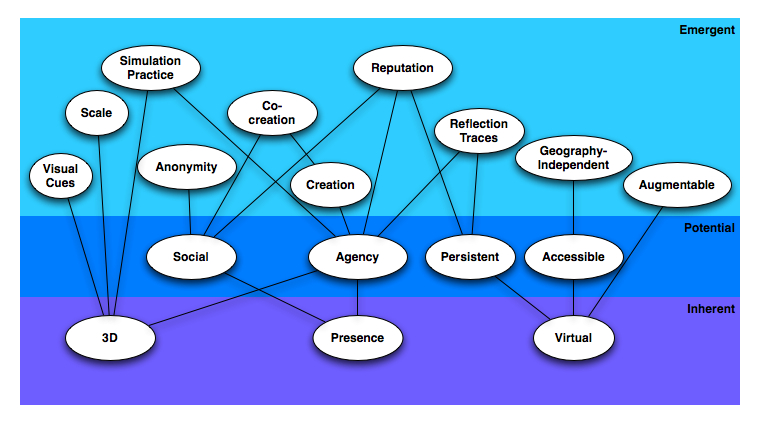I recently attended the 3DTLC conference, as I reported before. Chuck Hamilton presented on his (IBM’s) take on affordances on virtual worlds. Given that I’ve opined before, I asked for more detail on their take, and he was kind enough to forward to me their definitions. I like what they’ve done, but it led me to try to refine what I see as some confounding (they actually separate several of their 10 into two separate ones), and try to capture what I think are core, what can be enabled, and what then arise from those capabilities.
 I start with what I think are the core affordances of virtual worlds, that there’s a 3D world, that you can visit, and that’s digital. From there, I see that you can enable others to be there (social), you can enable action (agency), the world can be kept around (persistent), and it can be made accessible broadly (e.g. through the internet).
I start with what I think are the core affordances of virtual worlds, that there’s a 3D world, that you can visit, and that’s digital. From there, I see that you can enable others to be there (social), you can enable action (agency), the world can be kept around (persistent), and it can be made accessible broadly (e.g. through the internet).
If you choose to enable those (and you should, in most cases), you get some emergent properties. Chuck talked about a universal visual language, and you certainly can both tap into, and establish, visual cues. The scale does not have to be real, but can indeed scale down to and up to any size you want, in part or all.
You can choose to be anonymous, but if you don’t and choose to have a representation that is active over time, you can establish a reputation.
By being active, you can also enable practice opportunities such as simulations, scenarios, and games. If agency includes not just interaction, but creation, and you have social, you can have co-creation (one of the most exciting opportunities for informal learning). The persistence of your activity creates the opportunity to capture traces for reflection, e.g. ‘after-action review’.
The fact that it’s digital means it can be augmented with external capability: media, applications, and more. Also, you can be at least geography-independent, if not chronologically-independent.
This is a preliminary stab at trying to trace the initial, potential, and consequently emergent affordances, by no means do I think it’s the definitive answer. Feedback solicited!